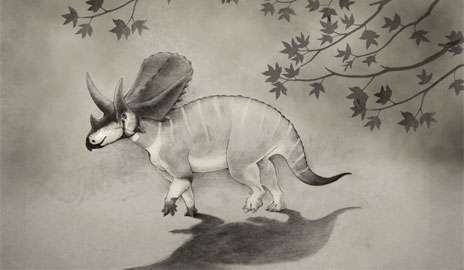(Phys.org) —The earliest known cousin of Triceratops and Torosaurus—the best-known horned dinosaurs—has been identified based on fossils from north central Montana, further underscoring the diversity of large, plant-eating horned dinosaurs among the fauna of western North America 66 to 80 million years ago.
By now, fossil remains of at least 18 closely related dinosaurs from the region have been identified as distinct species, and Yale researcher Nicholas Longrich expects others will be discovered.
"We keep finding new species, because cerotopsids—horned dinosaurs—evolved so rapidly," said Longrich, the postdoctoral researcher who identified the latest addition to the family, Judiceratops tigris. "These species show up for just a couple million years, or even a far shorter time, before another species replaces it. As you move up into younger rocks or down into older rocks, you get new species and no longer see the old ones. There was a lot of turnover."
Longrich reports the details of his research in a paper published in the spring edition of the Bulletin of the Peabody Museum of Natural History.
Identified by analysis of skull fragments belonging to four previously collected specimens in the Peabody's collection, Judiceratops lived during the late Cretaceous era, about 78 million years ago, or 12 million years before the more familiar Triceratops and Torosaurus. Judiceratops is the earliest known member of the chasmosaurines, a group of horned dinosaurs characterized by an enlarged frill on the back of the skull. It does not appear to be a direct ancestor of Triceratops and Torosaurus, Longrich said.
Judiceratops was likely a large plant-eating dinosaur that fed on low-growing vegetation, such as ferns, like other members of its family. It had two large horns over the brow and a smaller horn on its nose.
The three-horned Judiceratops differs from all other horned dinosaurs in the shape and arrangement of the scallops on the edge of the frill, which are large and triangular toward the front, and low and blunt toward the back.
The ornate frills might have been a way for the dinosaurs to attract mates and intimidate rivals, Longrich speculates, as some birds (modern dinosaurs) do through elaborate plumage or song.
"These are very bold, conspicuous display structures," Longrich said of the frills, which might also have served a defensive purpose.
The name Judiceratops tigris refers to the site where the fossils were found—in the Judith River Formation of Hill County, Montana, northwest of Havre—and to the Greek words "ceras" (horn) and "ops" (face). Tigris is a nod to the Princeton researchers who originally found the fossils and eventually gave them to the Peabody Museum at Yale. (The tiger is Princeton's mascot.) The age of the river formation, combined with radiometric dating, helped determine Judiceratops' age.
In recent years Longrich has identified several previously unrecognized dinosaur and lizard species—including the Obamadon, Mojoceratops, and Leptorhynchos—generally through close examination of overlooked fossils in existing museum collections.
Provided by Yale University























